Vienna and wine have formed a unit for centuries, and if the obvious similarity of the letters had not already existed, they would have had to be invented. The very mention of both words is likely to make many a visitor to Vienna feel like going to a wine tavern. Certainly, the Heuriger (= Buschenschank, Besenwirtschaft) was and is of great importance for wine and the city, but the great era of this institution has been over for a good 20 years. The death of the Heuriger is conspicuous, whereby most of the remaining establishments have basically become inns and sometimes almost restaurants. What has remained of the centuries-old tradition, however, is the unbroken association of cosiness combined with a gentle world-weariness - and, of course, the mixed sentence.
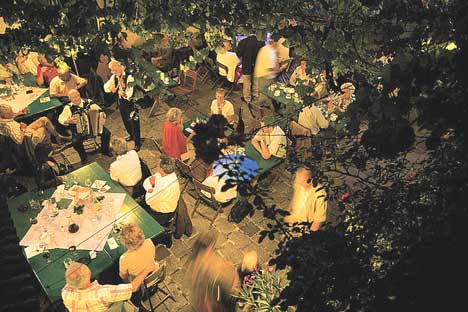 |
| Heurigen atmosphere in Vienna (Copyright: ÖWM/Lammerhuber) |
After a period of stagnation and even decline in cultivated vineyards, they are now increasing again and currently cover close to 700 hectares. This can be attributed both to the increased interest in quality wine and to an unprecedented desire for winemaking itself. Nevertheless, even the quantities produced in the meantime do not seem to be enough, because the Viennese and their guests more or less drink the almost 2.5 million litres per year themselves.
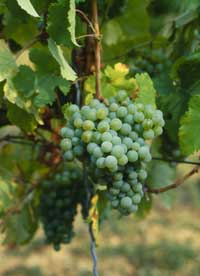 |
| Grüner Veltliner (Copyright: ÖWM/Faber) |
The most important grape varieties are Grüner Veltliner (25 %), Riesling (14 %) as well as Weißburgunder, Chardonnay and Zweigelt (8 % each). If one takes the Gemischter Satz as a separate wine or "grape variety", it also comes to a good eight percent of the total. The share of white wine is about 80 percent, with red wine still slightly increasing, as is the case everywhere in Austria. 86 percent of the vineyards are in the 19th and 21st districts. The proportion of Riesling is exceptionally high in Austria, and as an additional speciality, Neuburger and Traminer are often found in Vienna. Gemischter Satz is a wine made from grapes harvested together, pressed together and fermented together. This was a widespread way of pressing wine in past centuries, but was already particularly cultivated in Vienna at that time. When some dedicated winegrowers heralded the renaissance of quality winegrowing at the end of the last century, it was a particular concern not only to continue this tradition, but to revive it additionally. As a visible sign of the success of this commitment, in 2009 the "Wiener Gemischter Satz" was accepted as a passenger of the "Ark of Taste" by Slow Food.
With its almost 700 hectares, Vienna is not the smallest Austrian wine-growing region (Southern Burgenland and Western Styria are even smaller), but it is the most heterogeneous in such a small area. This was already known in past centuries; even then, people paid attention to the exact origin, right down to the location and even parts of a location. Therefore, one should pay more attention to the small areas within the region.
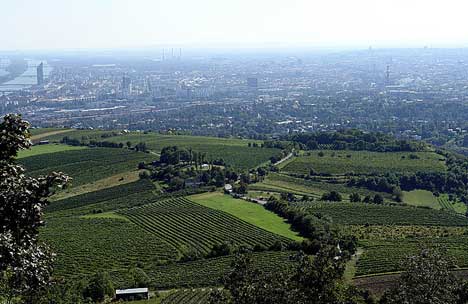 |
| Vienna - Vineyards (Copyright: ÖWM/Egon Mark) |
Oberlaa (10th district) is, from the point of view of vineyards, a newcomer, since the vineyards of that time had been almost completely grinded down for the Vienna International Garden Show in 1962. Afterwards, new sites were planted out, with excellent results. The Pannonian climate influence and the somewhat heavier soil favour red wine and Grüner Veltliner. The wines tend to be full-bodied, but also mineral.
Mauer (23rd district) is also located in the south of Vienna, the best sites are Kroissberg and Kadoltzberg. The often very heavy soils with good water storage and the southern exposure favour the cultivation of red varieties. The wines can be very powerful.
Ottakring (16th district): Only very small areas on the Wilhelminenberg remain of the formerly important vineyards of the winegrowing village. The brown earth soils allow the vinification of rather subtle Grüner Veltliner.
Dornbach (17th district): One of Vienna's very famous vineyards dominates here, namely Alsegg, a hillside site with a southern exposure. It is still owned by St. Peter's Abbey in Salzburg and is cultivated by the Mayer winery on Pfarrplatz. The proximity of the Vienna Woods brings strong temperature fluctuations, so the Rieslings from Dornbach are usually aromatic, lively and animating.
Neustift (19th district): Wine has been grown in Neustift am Walde and Salmannsdorf for over 800 years. The Mitterbergen and Neubergen vineyards in Neustift am Walde are among the most beautiful closed vineyards in Vienna. They are sheltered and produce rather elegant and aromatic white wines with often astonishingly high ripeness.
Sievering (19th district): Hackenberg is considered a top site, for many wine lovers it is one of the best three in Vienna. With not quite five hectares, it covers a rather large area by Viennese standards. The
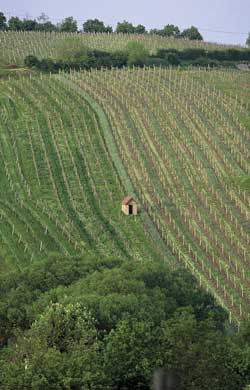 |
| Vienna - Grinzing (Copyright: ÖWM/A.Faber) |
The soils in Sievering are quite varied, as are the wines. The Rieslings are often powerful, with the typical Viennese acidity balancing them well.
Grinzing (19th district): Very good sites in Vienna's best-known Heurigenort are Steinberg, Oberer and Unterer Reisenberg, most of Nussberg and Hungerberg, where red wine varieties tend to be grown. The soils are mostly stony and often rich in limestone. Grüner Veltliner, Riesling, as well as Weißburgunder and Traminer often turn out here fragrant and mineral, sometimes especially the Rieslings are reminiscent of Rheingau wines.
Nussdorf (19th district): Here the Nussberg with its various small vineyards is the vineyard that also gives its name. Calcareous soils, ideal slope, proximity to the Danube and good ventilation make it the most sought-after site in Vienna. Riesling, Grüner Veltliner, Pinot Blanc, Traminer, Neuburger and Gemischter Satz, but also Pinot Noir achieve high quality, are often powerful and at the same time animating.
The Kahlenbergerdorf (19th district) is almost hidden on the road from Vienna to Klosterneuburg. The relatively steep slopes at the back of the Nussberg are planted with Pinot Blanc, Grüner Veltliner and Pinot Noir. The largest estate here is owned by the monastery Klosterneuburg.
Jedlersdorf (21st district): On the gentle slopes and foothills of the Bisamberg, the vines stand on warm, sandy-loamy soils. They produce medium-bodied white wines and especially remarkable red wines.
Stammersdorf (21st district) is a long, quiet wine village where some of Vienna's most active and best winegrowers are based. Very good sites here include Oberer Jungen Herrnweg and Unterer Jungen Herrnweg on the south-eastern slopes of the Bisamberg. Sandy loess soils as well as gravel and limestone are equally good for white and red varieties, the wines like to be medium to strong, animating at the same time and often mature surprisingly well if given the opportunity.
Strebersdorf (21st district) has retained its village charm as a traditional wine tavern and wine village to this day, and the Kellergasse is more than worth seeing. The vineyards are also located on the slopes of the Bisamberg, the mineral-rich loess soils favour the pressing of Burgundy varieties and Merlot into quite powerful wines with good backbone and structure.
As in many other areas and regions that awoke from a certain stagnation to new life, some prominent personalities in Vienna have been particularly committed to renewal. It would go beyond the scope to name them all, but Herbert Schilling, Fritz Wieninger, Franz Mayer (†), Michael Edelmoser, Richard Zahel and, politically as well as privately committed, Mayor Michael Häupl as mentor of the Vienna Wine Award have rendered special services to progress. They were and are also the ones who partly created and shape the two most important associations for Viennese viticulture, Vienna Classic and Wien Wein. Wien Wein is currently setting the tone, especially in terms of media presence, measured by the ideas, the commitment (among other things, against land speculation) and the quality potential within the group.
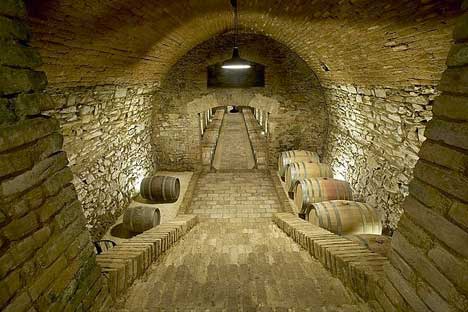 |
| Wine cellar - Wieninger Winery (Copyright: ÖWM/Weing Estate Wieninger) |
Another small association, quite unique in its form, is that of the Orchid Winegrowers. This is a marketing association of hobby winegrowers who, however, work more than seriously and are not infrequently at the forefront of important awards. In general, the wine-growing region of Vienna is one of the few where a large number of lateral entrants and non-speculative investors have a considerable influence on the wine scene and are often involved. It is not least thanks to them that many an important new sales opportunity has been created (for everyone), that old, often difficult varieties and clones have not died out, that Pinot Noir, which is absolutely appropriate here, is being increasingly cultivated again and that the Heurigen culture seems to be finding a contemporary form. Conversely, the old-established winegrowers have made this possible by giving the newcomers all the support they can, whether in the vineyard, in logistics or in the vinification of the wines. Such a fruitful symbiosis with mutual appreciation and recognition is not only a blessing in viticulture, but also forms a visible counterpoint to false globalisation, cold profit thinking and the de-solidarisation of society.
Viennese cuisine and Viennese wine have always been a topic in the city, but for several decades they were mainly limited to the small pubs, called "Beisl" in Vienna. For some years now, this has changed, and local cuisine, mostly positively adapted to today's needs, is experiencing a formal boom. The pleasing thing about this is that it is very often not speculative tourism cuisine, but mainly aims to appeal to Viennese guests and is successful in doing so. In the course of this, Viennese wine is also offered to a greater extent; at present there is no restaurant worth mentioning that does not have a satisfactory selection of Viennese wines on its menu. One restaurant, however, deserves special mention: the WienO. Here you can find practically all Viennese wines and get any information about them; it is de facto the tasting centre for the region, with moral and logistical support from the winegrowers.
Viennese wine has changed, in part the good tradition is emphasised more clearly, in part new, but not zeitgeisty-tasteful ways are taken. Old-established and new wineries form a unity and together offer an unprecedented variety of distinctive wines typical of the region.